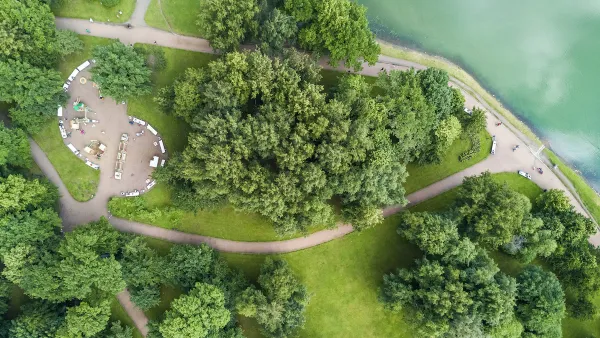Creating parks that benefit and reflect the needs of the communities that use them is the goal for both planners and landscape architects. Programming is a big part of this. So is design.
An article recently published in UrbDeZine titled “Thinking about the Park Planning Profession” irritated a lot of landscape architects by seeming to misrepresent the work they do creating parks. Although the writer, Clement Lau, a planner in the Los Angeles County Department of Parks and Recreation, goes out of his way to say his intention is “certainly not to criticize or discredit practitioners of landscape architecture,” he does so anyway. Which is fine, really – I’m all for sharing opinions and pushing constructive debate. But if you start the conversation, you have to be ready for it to continue. So here is what I think:
Lau’s basic argument, that the public needs to be better incorporated into the park planning process in order to create more equitable spaces and cities, is not new; and is certainly worth reiterating. Although he eventually makes this case fairly persuasively, he, for some reason, chooses to distract the reader right off the bat with an unnecessary us versus them scenario between park planners trained as landscape architects and those with a planning background, who he considers to be better at creating people-oriented places. He doesn’t provide real evidence for this but, rather, bases it on what are essentially crafted marketing blurbs by professional associations promoting their members. He uses a line from the website of the American Society of Landscape Architects (ASLA): “Landscape architecture encompasses the analysis, planning, design, management, and stewardship of the natural and built environments” – which is intentionally vague in order to capture the breadth and diversity of the profession – to criticize landscape architects as being more focused on place than people, suggesting the two are mutually exclusive (I should point out, in full disclosure, that I am a member of ASLA and currently sit on the Executive Committee of its Board of Trustees). He tries to bolster this argument by adding that, unlike APA and AICP, “the notion of equity is not mentioned in ASLA’s definition,” as if an entire profession can be guilty because of something not said in one sentence on a website.
Taking this contentious approach eliminates the possibility for Lau to strengthen his main argument by including the voices of landscape architects who promote similar perspectives on planning. Randy Hester, for instance – a well-respected Professor Emeritus of Landscape Architecture and Environmental Planning at UC Berkeley – has spent decades conducting research that applies sociology to the design of parks, neighborhoods and communities. He has taught several generations of landscape architects and planners about the democratization of design and how critical it is to include citizens in the planning of their own communities, basically echoing Lau’s position. Hester thinks the way he does because he cares about creating great places, not specifically because he is a landscape architect. I hope the same is true for Lau and others trained as planners.
Another problem with Lau’s piece is that he treats park planning and placemaking as separate things, implying that design is not important to the process. This attitude disregards the important fact that parks are, indeed, natural and built environments, and do not exist merely as programming diagrams or plans on paper. You can gather all the information you want from the public, but somewhere along the way these places need to get designed and built in order for people to enjoy them. Good parks are created by maximizing the synergy between programming and design, not by concentrating on how and why the two are different. You cannot separate people from place, regardless of what Lau wants us to believe.
The bottom line is that there are just too many wonderful parks out there planned and designed by landscape architects to call out the entire profession as being somehow detrimental to the process. The importance landscape architects place on social equity can be seen going back to the 19th century urban parks movement led by Frederick Law Olmsted, which was rooted in the imperative that parks should help to provide healthy cities for all people – regardless of class or privilege. But this is not just a glorified remembrance from the past. I follow today’s profession of landscape architecture very closely as both a writer and a practitioner, and can say with a high degree of confidence that their work as a whole still embodies this way of thinking. Involving the public in the creation of parks and other public spaces is not an exception to any rule; it is just good, responsible practice.
Lau is not the first person to accuse landscape architects of favoring design over people. In fact, his criticism is relatively polite. Fred Kent, the president of Project for Public Spaces, has been spouting his own one-note, anti-design mantra for decades – once telling the New York Times that design professionals, including landscape architects, architects and urban designers, "have distanced themselves from serving the communities whose interests they should be reflecting or even understanding what those communities' needs are.” That is pretty harsh, especially considering he fails to offer up any justification for this beyond his personal opinion.
I worked with Kent on a project a few years ago and have nothing against him personally. He is a nice guy and not without some good ideas. However, his habit of insulting the people who actually get places built, along with his insistence on promoting a formulaic prescription for placemaking – one based on the fundamentally flawed premise that people are attracted to places because there is a certain amount of stuff plopped in them – keep him from becoming more than a fringe figure in the design of cities.
Kent and Lau preach basically the same argument, they just come at it from different angles. Great parks, so they say, are born out of laundry lists of programmatic elements developed with heavy input from the public. Landscape architects, in turn, muck it up by just trying to make things pretty. Or something like that.
What they both fail to recognize is that people are attracted to the places themselves, not just what is in them. It can never be just about program. Less tangible things, such as the quality of space, the orchestration of elements, and the reflection of the culture and context of a specific site – things that landscape architects deal with – are what make places, including parks, special.
An effective program surely makes for a better park, but even the best program is wasted without the benefit of good design.

Planetizen Federal Action Tracker
A weekly monitor of how Trump’s orders and actions are impacting planners and planning in America.

Chicago’s Ghost Rails
Just beneath the surface of the modern city lie the remnants of its expansive early 20th-century streetcar system.

Amtrak Cutting Jobs, Funding to High-Speed Rail
The agency plans to cut 10 percent of its workforce and has confirmed it will not fund new high-speed rail projects.

Ohio Forces Data Centers to Prepay for Power
Utilities are calling on states to hold data center operators responsible for new energy demands to prevent leaving consumers on the hook for their bills.

MARTA CEO Steps Down Amid Citizenship Concerns
MARTA’s board announced Thursday that its chief, who is from Canada, is resigning due to questions about his immigration status.

Silicon Valley ‘Bike Superhighway’ Awarded $14M State Grant
A Caltrans grant brings the 10-mile Central Bikeway project connecting Santa Clara and East San Jose closer to fruition.
Urban Design for Planners 1: Software Tools
This six-course series explores essential urban design concepts using open source software and equips planners with the tools they need to participate fully in the urban design process.
Planning for Universal Design
Learn the tools for implementing Universal Design in planning regulations.
Caltrans
City of Fort Worth
Mpact (founded as Rail~Volution)
City of Camden Redevelopment Agency
City of Astoria
City of Portland
City of Laramie






























